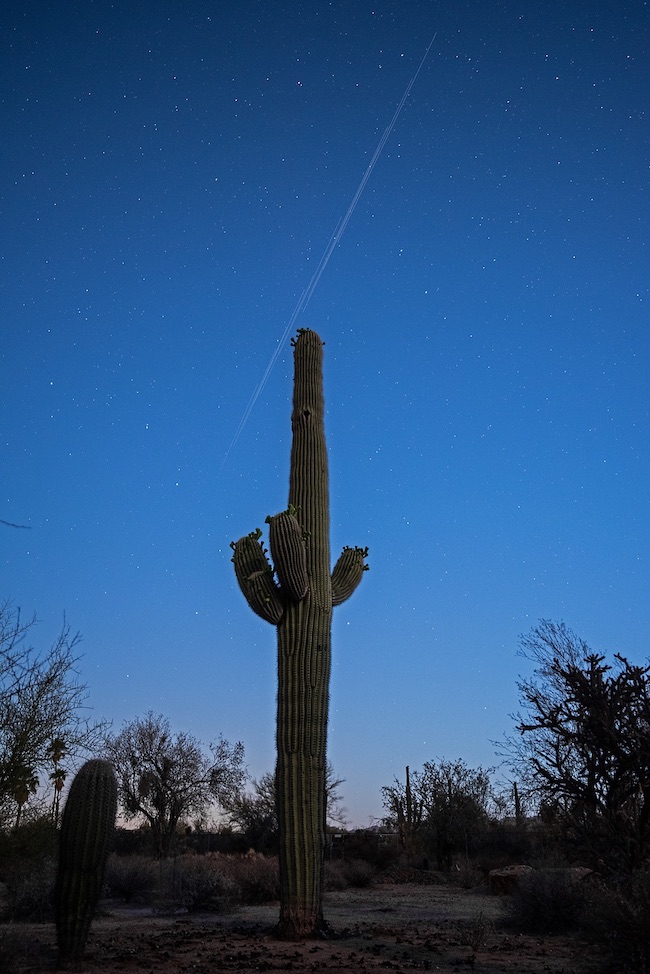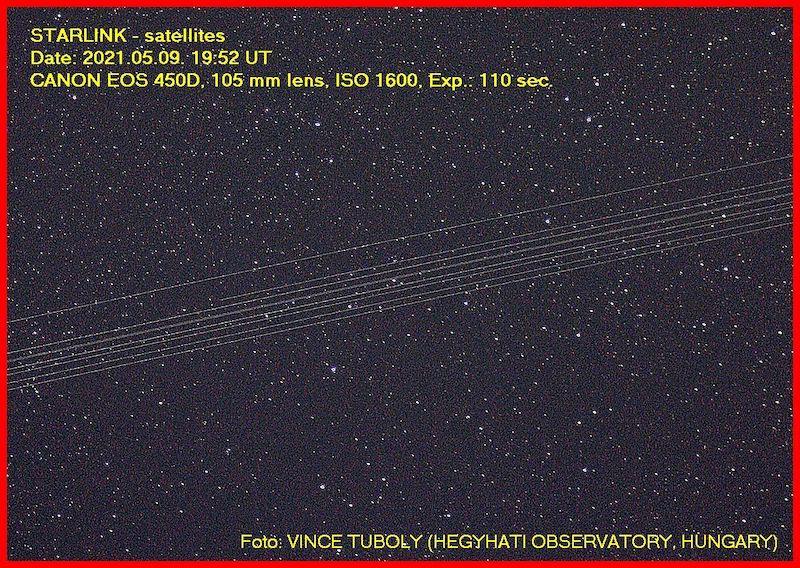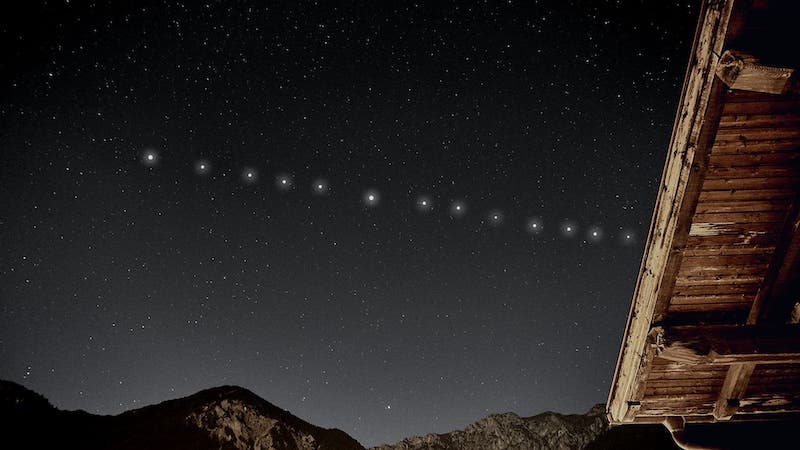
What’s that long line of lights in the sky like a train? It’s Starlink
After every Starlink launch, people flood the internet asking, “What’s that long line of lights in the sky that looks like a train?” Usually, people are seeing Starlink satellites. You can often spot them for up to a day or two after launch. To some they may look like a long unbroken line of light moving across the sky, while others are able to see the individual dots of each satellite. This train of light is generally 46 separate satellites heading upward from Earth, moving into their future orbits. When they reach their final orbit, they are often too high for people to see without optical aid. Astronomers, however, still must contend with them.
In this video, you can watch as a train of Starlink satellites passes overhead.
Grateful that my neighbor talked me down from us being attacked by aliens and that it was only the #starlink satellite. #rad #science pic.twitter.com/gCSDRQubpN
— ?? hi, i’m katie (@kswansondesign) August 21, 2022
We have received multiple calls into the newsroom about a line of fast-moving lights in the sky tonight. It's the #Starlink satellites @upnorthlive pic.twitter.com/ku3Xat7psW
— Amanda Skrzypchak (@AmandaTVNews) August 23, 2022
This website might help you see the Starlink satellites in your sky
What are the Starlink satellites?
Starlink is the name of a satellite network from SpaceX that provides broadband coverage for high-speed internet access, particularly for rural and remote areas. Over the coming few years, SpaceX plans to send up at least 12,000 Starlink satellites. Satellite internet beams through space at a rate that’s reportedly 47% faster than fiber-optic cable internet. All well and good.
But the Starlinks are bright. People see them in the night sky. They create what’s being called a megaconstellation, that is, groups of satellites moving together. Is the sudden upsurge in the number of Starlink satellites also causing UFO sightings to increase? Plus, astronomers are worried. The Starlink satellites are photobombing astronomical images. They have the potential to interfere with the professional observations that have brought us our modern-day view of the cosmos.
Internet from space
SpaceX CEO Elon Musk announced the proposal for Starlink back in January 2015. Though it didn’t have a name at the time, Musk said that the company had already filed documents with international regulators to place about 4,000 satellites in low-Earth orbit. He said in a speech when revealing the project:
We’re really talking about something that is, in the long term, like rebuilding the internet in space.
And his predictions so far have proven true. Musk’s initial estimate of the number of satellites quickly grew, as he hoped to capture a part of the estimated $1 trillion worldwide internet connectivity market. The U.S. Federal Communications Commission (FCC) has granted SpaceX permission to fly 12,000 satellites, and perhaps as many as 30,000 eventually.
To put things into perspective: as of January 1, 2022, there were 4,852 active satellites orbiting Earth. On September 1, 2022, 2,386 of them were Starlinks. When we first wrote this article in May 2021, humans had launched fewer than 9,000 objects into space in total. As of September 3, 2022, according to the United Nations Office for Outer Space Affairs, we’re up to 13,672.
Where are the satellites?
Starlink satellites orbit at an altitude of 340 miles (550 km). At that height, they’re low enough to get pulled down to Earth by atmospheric drag and burn up in a few years, so that they don’t become space junk once they die (a problem SpaceX may hope to tackle using Starship). Each one weighs 500 pounds (227 kg) and measures about the size of a typical coffee table, according to Skyandtelescope.com.
It was exciting to see the first few Starlink satellites, traveling together in the night sky. But then more were launched, and then more. And astronomers began to worry.
Read more: 1 of every 15 lights in the sky will be a satellite

So many Starlink satellites
SpaceX’s two test satellites, TinTinA and TinTinB, launched in 2018. The mission went smoothly. Using that initial data, the company decided it wanted its fleet to operate lower than originally planned. Regulators deliberated and the FCC approved the move.
The first 60 Starlink satellites were successfully launched on May 23, 2019, aboard a SpaceX Falcon 9 rocket. Since then, SpaceX has been launching from 46 to 60 Starlink satellites at a time.

Starlink controversy among astronomers
Despite the promise of high-speed broadband internet, SpaceX has taken criticism within the astronomical community for its Starlink satellites, due to their brightness and potential to disrupt observations of the night sky.
The National Science Foundation and the American Astronomical Society released a report on the situation in August 2020. Discussions among more than 250 experts at the virtual Satellite Constellations 1 (SATCON1) workshop expressed concern that the bright train of satellites marching across the sky will hinder their observations.
SpaceX response to astronomers
In response, SpaceX has begun outfitting their satellites with a blackened sunshade – called VisorSat – that the company hopes will reduce the satellite’s apparent brightness by reducing the amount of sunlight that’s reflected. This is just one of the six suggestions proposed by the SATCON1 team.
Initial efforts at mitigating the spacecraft’s impact involved launching a prototype Starlink satellite later dubbed DarkSat in 2021, which featured a black antireflective coating. Ground-based observations of DarkSat in orbit found it half as bright as a standard Starlink satellite, which is a good improvement, according to experts, but still far from what astronomers say is needed. Jeremy Tregloan-Reed, a University of Antofagasta astronomer on the observational team that assessed the prototype, commented:
I would not consider DarkSat as a victory but instead a good step in the right direction.
The team compared DarkSat with a typical Starlink sibling using a two-foot (0.6-m) telescope at the Ckoirama Observatory in Chile and found that although DarkSat’s antireflective coating rendered it invisible to the unaided eye, it remained far too bright to avoid interfering with the Vera C. Rubin Observatory – now under construction in Chile – and other major telescopes. Additionally, DarkSat’s darker color retains too much heat, so the company is sticking with the visor alternative instead.
Futured satellites in our sky
With SpaceX’s plans, plus Amazon’s Kuiper project, OneWeb, China’s Hongyan, and other projects launching their own global networks of hundreds or thousands of satellites with little to no regulation, the scale of astronomy’s satellite-constellation problem might only increase.

Bottom line: Have you seen a group of bright satellites crossing the night sky together? They are likely SpaceX Starlink satellites, a bright, large, moving megaconstellation. Starlink’s goal is to provide global broadband coverage for high-speed internet access, especially for rural and remote areas. Astronomers and skywatchers worry about Starlink’s potential to interfere with their work understanding the universe and their enjoyment of the night sky.
The post Starlink is the line of lights you see in the sky first appeared on EarthSky.
0 Commentaires